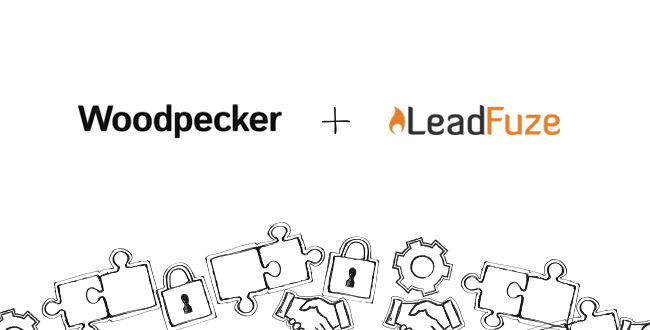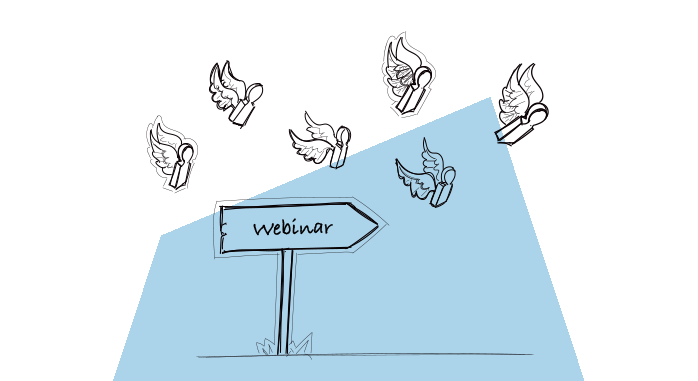Inbound vs Outbound – this seems like an endless dispute to me. On the one side, you’ve got people who claim outbound techniques are just wrong and unethical, whereas inbound is the only effective way to generate new valuable leads. On the other side, there are people who strongly advocate outbound, because that’s what has really worked for them like no inbound tactic before. So whose advice are we supposed to follow? Which one works better in B2B: inbound vs outbound marketing?
Inbound vs outbound lead generation
In inbound, you’re supposed to be there for your potential customers and wait for them to come to you, get interested, get engaged, and in effect, buy your service or product. Each time you:
- improve your website to show the value of your product or service,
- write a blog post,
- create a new ad for AdWords or Facebook,
- make graphics, infographics, and SlideShares,
- engage in communication on social media, forums and in industry communities,
- care about your customers to make them more eager to give referrals,
you invest in inbound lead generation.
In outbound, you’re supposed to target your ideal customers and proactively reach out to them to start a conversation. You’re supposed to build business relations with your prospects, and in effect, have them buy your service or product. Each time you:
- search for ideal prospects on LinkedIn,
- research a specifically chosen company matching your ICP,
- send a cold email,
- make a cold call on the phone,
- reach out to a prospect on social media,
you invest in outbound lead generation.
Which one’s better?
Inbound vs outbound marketing? Well, both of them have their pros and cons. Both of them work if done right. Neither of them works, if done poorly.
➡️ Read more about the difference between inbound and outbound lead service.
Inbound pros & cons
Pros
What’s done once, will work for you over years
For me, that’s the greatest advantage of all inbound tactics. If you work out some valuable content, it’s there to attract new people every day. Sure, after some time it may call for an update. But an update is just an extension to what you’ve already created – it’s not as time-consuming as creating something new from scratch.
I’ve been writing this blog for almost two years now. And the posts I wrote at the very beginning are still helping my readers today. I put together the 15 Cold Email Templates ebook over 1,5 year ago, and people are still signing up to download it. Our followers’ group on Twitter is growing every day, it’s not going to suddenly vanish.
Inbound is a long-term investment, but it’s an investment that pays off.
You build your position as an expert
Creating all those materials, you learn a lot and grow your skills. You become a person who knows this and that, and more, about your topic. You’re becoming a kind of an expert in your narrow field. That means you’re becoming more apt to help your prospects. And the better you help, the easier it is to sell your product or service as a result of the helping.
After some time, people start to associate you with your field of expertise. They start to trust you, and they’re more eager to buy from you.
You let your prospects freely go through their buying cycle
If you’re in the team inbound, you trust that when your ideal prospects will be searching for the kind of product or service that you’re offering, they will find you. You’re trying to provide them with all the necessary information. You’re trying to help them find all they need to finish their research with the right buying decision in the end. You just guide them and allow them to come to the buying decision in a moment that they feel is right.
As a result, you acquire pretty well-educated customers who notice and understand the value of your product. And these are the most desired customers indeed.
➡️ Read more about building an effective outbound sales team.
Cons
You have to wait longer to see some results
You need to invest a lot before you see some returns. It’s not only about content creation but also about promotion. You need to create various forms of content and employ various channels to distribute the content. Firing those channels off takes more time than you think. Then, you need to build some audience. And this audience will also need some time to get engaged in your messaging and to build trust towards you before they become actual leads.
It’s a long-term process. Before you’ll be able to test your hypotheses and get some reliable results, there’s a time when you invest lots of time and hard work and see little in return. You have to be patient.
The influx of leads is unpredictable, especially at the beginning
Each time you write another post or prepare another marketing campaign, you’re not sure if it’s going to bring you 100 new leads or 10. In the beginning, it’s difficult to estimate the effect of inbound activities. You do your best and keep your fingers crossed in the hope that this time you’re going to see some reward for your hard work. The sad thing is, though, sometimes you see the reward, and sometimes you don’t.
The skill of predicting the results takes time and experience, and it’s something you can’t learn overnight.
You have limited targeting options
In inbound, you only get to choose a profile of the prospect you’re aiming at. You’re not choosing individual companies and specific people to become your clients. You can organize your marketing activities around a few previously created personas, but those will be only concepts.
You can attract less-than-ideal customers
No matter how hard you try to keep your content focused around your ideal customer profile, there are always some leads who get hooked up even though you haven’t targeted them at all. There will be some people who signed up for a trial out of curiosity and never had a chance to become customers. There will always be some people who will be close to your ICP, but some of the characteristics of their business won’t let them succeed with your product.
My point here is that in inbound, you have limited control over the quality of leads you get.
Outbound pros & cons
Pros
You get to choose your ideal prospects
In outbound, you’re the one who does the research. You’re the one who decides which companies to start a conversation with. You’re the one who chooses their customers. And you can choose specific accounts and people that you want to work with. You’re the one who takes action first. And this action is to bring you an actual business conversation with a potential customer.
All you need to do is contact people
You don’t need an experienced marketing team armed with a professional set of tools to do outbound. All you need is an email account (and maybe a phone if you prefer this way of contacting people). Sure, cold emailing is a skill you need to acquire. But you need much fewer resources to get started and learn.
After some time, when you feel the need to scale your outbound activities, you’ll need some tools and new team members to help you handle the expansion. But the start is much easier than in inbound and brings results faster.
You can quickly build a predictable source of leads
The greatest advantage of outbound lead generation is that you can test your hypotheses fast. You send the first version of your message to a few dozens people and observe reactions. If it works, you proceed and improve. If it doesn’t, you make changes and send the second version. And so on. The best part is, you don’t have to wait for the people to come and see your work. You decide when to get in front of the people. And you get straight to their inbox.
Additionally, you can easily measure the effects of your activities. You see how many of your prospects replied, and how many of them replied positively.
A series of alterations in your outbound campaigns allows you to build a predictable source of leads within weeks.
You get to actually talk to ideal prospects
Outbound techniques are based on conversation. The aim of all your marketing activities in outbound is to talk to your prospects, listen to their problems, learn their needs and help them find solutions. You don’t just create content, put it out there and observe reactions. You start a business connection based on interaction. You get a verbally expressed feedback.
This opens the gate to the best way of learning the specifics of your target group. Even if you don’t close an impressive number of deals at the beginning, you’ll draw an amazing amount of first-hand information from your ideal customers. This is the scope knowledge no other method will give you. And this is something no one will take away from you.
Cons
Prospect research is time-consuming
Yes, if you want to prepare a good prospect base for a personalized outbound campaign, it will take you some time. You will have to do some serious research and look for information that will help you qualify a company as a prospective client – and specific people within this company as decision-makers.
You can’t be sure if the prospect is at the right point of their buying cycle
You can look for some hints during your research. But you will never be 100% sure that the companies you chose to be your prospects will be ready to talk to you at the moment when you reach out to them. The good thing is, though, that they will tell you in case they are not ready.
And how about all-bound?
What’s interesting about outbound and inbound tactics is that they are often presented as contrary to each other and mutually exclusive. As a marketer, you’re supposed to take sides and either be in team ‘inbound’ or team ‘outbound.’
And I don’t quite understand why on Earth should this work like this. Why should you embrace one set of marketing methods, and turn your back to the other? It’s like you’re only using half of the options you have available and deliberately reject the other half for no good reason.
The two are not mutually exclusive. There’s no inbound vs outbound marketing. In fact, if properly combined, they can empower each other.
If you have a well-developed content base and an awesome website, you’re more likely to get a response to your cold emails. And if you’re contacting carefully chosen prospects via cold email, the chances that they will check out your content are obviously greater because they will want to see who you are before they reply.
You can have a list of subscribers for your ebook, and send them an automated sequence of emails with additional materials to learn from in hopes they will get interested in your product eventually. But you can also research those people, and contact them personally to start a conversation.
Using the two types of marketing tactics – outbound and inbound in combination is something that we like to call allbound.
Actionable tips for marketers
We’ve gathered all the actionable tips from the article to help you enhance your inbound and outbound lead generation efforts. Use these strategies to improve your sales funnel and connect with potential customers more effectively.
- Build a sales funnel by combining inbound marketing strategies and outbound sales strategies.
- Use an inbound marketing strategy to attract a target audience and prospective customers through valuable content.
- Focus your inbound marketing efforts on creating content that engages potential customers.
- Create a personalized inbound sales process to nurture leads and guide them through their buying journey.
- Incorporate outbound sales strategies to proactively reach outbound leads through direct outreach.
- Leverage your sales team to combine inbound strategies with outbound marketing efforts for a well-rounded approach.
- Train sales reps to manage both inbound leads and outbound leads effectively for better conversions.
- Ensure your inbound marketing focuses on providing valuable information to guide potential customers through the sales funnel.
- Use inbound marketing efforts to build trust and credibility with potential customers before the outbound sales team reaches out.
- Don’t be afraid to use and mix both outbound and inbound marketing content.
What’s in it for you?
The one important thing I’d like you to remember from all this is: don’t reject inbound or outbound marketing for no good reason. Both of them require some time to learn. Both of them require a set of processes to be created in your organization. Both of them can be wrong if done poorly. And both of them will work great if you do them right.
And by right, I don’t mean “the only right way only I know and will share exclusively with my subscribers”. By right I mean “the way that works for your specific kind of business and your specific target group”. You’ll have to figure out the right for yourself. It’s not going to be easy, but in the end, it will be worth the effort.
I bet you have your two cents on the inbound vs outbound marketing discourse. I’d love to see those two cents in the comments section, feel free to put them in there.
Follow this up with this article, The difference Between Inbound And Outbound Lead Service >>
FAQ on inbound vs outbound marketing
What is inbound lead generation?
Inbound lead generation involves attracting inbound leads by creating valuable content, engaging in inbound marketing, and guiding potential customers through the inbound sales process. Tools like Woodpecker automate follow-ups, helping you nurture inbound leads effectively as part of your inbound sales strategies.
What is outbound lead gen?
Outbound lead generation relies on outbound strategies like direct mail, cold calls, and outbound marketing efforts to reach potential customers directly. With Woodpecker, your sales team can easily manage outbound email campaigns, making it a crucial tool for any outbound sales strategy.
Is demand gen inbound or outbound?
Demand generation can involve both inbound and outbound sales efforts. Inbound marketing focuses on creating content and building relationships, while outbound sales strategies target potential customers directly through outbound marketing and outreach activities.
Are event leads inbound or outbound?
Event leads can be both inbound and outbound. They might originate from inbound marketing efforts like webinars or be generated through outbound strategies like direct mail invitations or outbound marketing outreach before an event.
What is inbound sales?
Inbound sales focuses on building relationships with inbound leads by providing solutions to their problems. An inbound sales strategy relies on valuable content and inbound marketing to nurture leads, guiding them through the inbound sales process until they become customers.
READ ALSO

5 Ways a SaaS Sales Team Can Cooperate with Marketing for Better Lead Generation
Marketing and sales used to be portrayed in stark contrast. Nowadays, there's an ongoing trend to go for "sales and marketing alignment" -- that is, making the two teams work together. There's little information on how to do it exactly. Many focus on improving the flow of information between the two departments. Is that all that can be done? Today, I'll show you a couple of ways the Woodpecker marketing and sales teams cooperate to create a streamlined lead generation process.

Automate Prospecting and Outreach withLeadFuze + Woodpecker
Remember the time we reviewed LeadFuze for our prospecting tool review series? Now I can finally announce that Woodpecker has integrated with LeadFuze. And in this guest post, Justin McGill himself will tell you what you can do with the integration. Keep on reading to discover how you can benefit from using Woodpecker and LeadFuze according to Justin.

How to Generate More Leads After a Webinar?
I'm sure you can agree that webinars are time-consuming and stressful. Not only do you have to carefully plan the whole thing out, but you also need to oversee a lot of things, such as recording & sound quality, take care of the Internet connection, plus you need to make sure there's enough space for everyone to attend the webinar.

